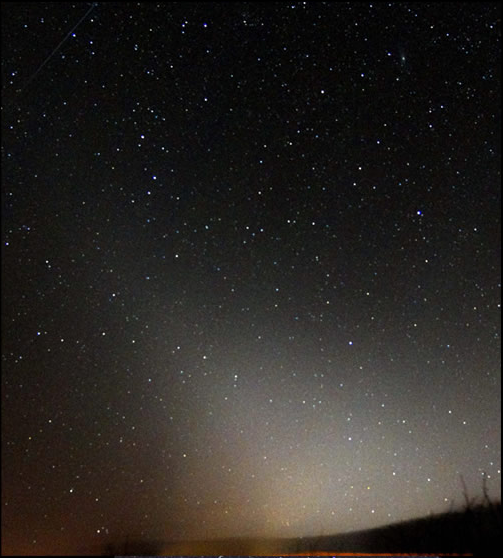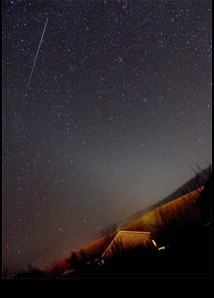Not only in the tropics
Not Only in the Tropics: Discovering the Zodiacal Light
Have you ever gazed at the night sky and marveled at the ethereal glow that seems to extend upwards from the horizon? This phenomenon is known as the zodiacal light, and it is a captivating display of sunlight scattered by interplanetary dust orbiting the sun. Traditionally observed from the tropics, recent images captured by Chris Brown from the Shetland Islands in Scotland reveal that this celestial spectacle can be enjoyed even at higher latitudes. Let's delve into the fascinating world of the zodiacal light and explore its mesmerizing characteristics.
Understanding the Zodiacal Light
The zodiacal light is created by tiny dust particles, measuring between 0.001 to 0.3 mm in diameter, that populate the plane of the planets in our solar system. These particles are widely dispersed, with miles separating each one from its neighbors. As sunlight interacts with these minuscule particles, it scatters in various directions, giving rise to the zodiacal light phenomenon.
A Soft Cone of Light
Picture a soft cone of light extending upwards along the ecliptic, which represents the plane of Earth's orbit projected onto the sky. The zodiacal light becomes visible approximately an hour after sunset or before dawn. While it may not be as bright as the Milky Way, its delicate glow captivates observers who are fortunate enough to witness it.
Optimal Viewing Conditions
To increase your chances of spotting the zodiacal light, it is essential to choose the right time and location. The best viewing opportunities occur when the ecliptic makes a steep angle to the horizon. In practical terms, this occurs during Spring after sunset and Autumn before dawn. By aligning yourself with these optimal conditions, you maximize your chances of experiencing this celestial wonder.
Defying Latitude Expectations
Traditionally associated with the tropics and low latitudes, the zodiacal light was considered a rare sight in higher latitudes. However, recent images captured by Chris Brown from the Shetland Islands, located at a latitude of 60° North, have shattered this preconception. With careful planning and a dark enough sky, Brown was able to capture stunning images of the zodiacal light, even at this northern location. His successful endeavor demonstrates that this awe-inspiring phenomenon is not limited to tropical regions but can be witnessed with patience and favorable conditions anywhere on Earth.
Equipment and Technique
To capture the zodiacal light in all its glory, Chris Brown utilized an Olympus E620 camera with an ISO setting of 1600. The lens of choice was the 11-22mm ZD, set to 11mm with an aperture of f/2.8. To ensure sharpness and stability during the long exposure, Brown employed a mini eq GEM for guidance. These technical specifications provide a valuable reference for aspiring astrophotographers seeking to immortalize the zodiacal light.
A Concentrated Display
While the zodiacal light can be observed from various locations on Earth, it is important to note that it is concentrated along the ecliptic. The ecliptic's steep angle to the horizon enhances the visibility of this celestial phenomenon, allowing it to shine through the darkness of the night sky. By understanding this concentration pattern, astronomers and enthusiasts can plan their observations more effectively.
In Conclusion
The zodiacal light, a breathtaking display of sunlight scattered by interplanetary dust, has long been associated with tropical regions. However, recent photographic evidence from the Shetland Islands in Scotland challenges this notion and reveals that the zodiacal light can be observed at higher latitudes as well. By choosing the right time, location, and equipment, it is possible to capture the ethereal beauty of the zodiacal light from various parts of the world. So, the next time you find yourself gazing at the night sky, remember to keep an eye out for this celestial wonder that transcends geographical boundaries.


Zodiacal Light from 60° North ~ A sight normally seen from the tropics imaged last night (13th February) from the Shetland Islands, Scotland by Chris Brown. ©Chris Brown, shown with permission.

The zodiacal light is sunlight scattered by interplanetary dust orbiting the sun in the plane of the planets outwards to the distance of Jupiter and beyond. The dust particles are 0.001 � 0.3 mm across and each is separated by miles from its neighbours.
The light is a soft cone extending upwards along the ecliptic (the plane of Earth�s orbit projected on the sky) an hour or so after sunset or before dawn. The best time to try to see it (it�s no brighter than the Milky Way) is when the ecliptic makes a steep angle to the horizon. This is in Spring after sunset and Autumn before dawn.
The tropics or at least low latitudes are the favoured locations but Chris�s images far north at 60� show that given care and a dark enough sky (he chose a new Moon) it is visible anywhere.
Chris used an Olympus E620, ISO 1600, 11-22mm ZD at 11mm, f/2.8 60s exposure guided on a mini eq GEM.
The light is concentrated along the ecliptic and is best seen when the latter makes a steep angle to the horizon.
Note: this article has been automatically converted from the old site and may not appear as intended. You can find the original article here.
Reference Atmospheric Optics
If you use any of the definitions, information, or data presented on Atmospheric Optics, please copy the link or reference below to properly credit us as the reference source. Thank you!
-
<a href="https://atoptics.co.uk/blog/not-only-in-the-tropics/">Not only in the tropics</a>
-
"Not only in the tropics". Atmospheric Optics. Accessed on November 25, 2024. https://atoptics.co.uk/blog/not-only-in-the-tropics/.
-
"Not only in the tropics". Atmospheric Optics, https://atoptics.co.uk/blog/not-only-in-the-tropics/. Accessed 25 November, 2024
-
Not only in the tropics. Atmospheric Optics. Retrieved from https://atoptics.co.uk/blog/not-only-in-the-tropics/.